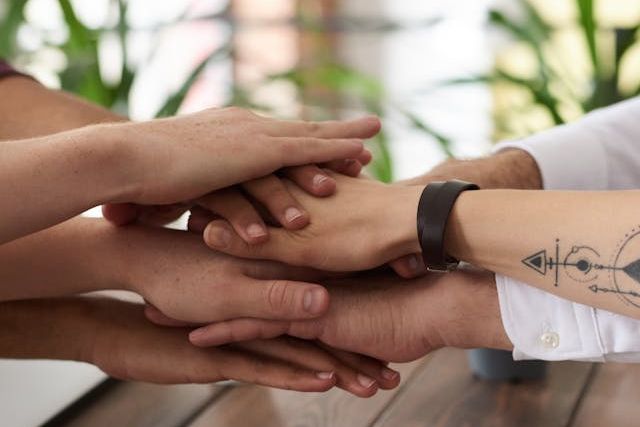In a world that is increasingly valuing diversity and inclusivity, love and relationships are also subject to this seismic shift toward acceptance and equity. The traditional cookie-cutter mold of what a relationship should be is breaking, giving rise to a new paradigm that celebrates differences and prioritizes inclusion. This post is a heartfelt exploration of the inclusive relationship meaning, how it affects individuals, and how we can mold our partnerships to reflect these evolving values of our society.
Understanding Inclusive Relationships
An inclusive relationship goes beyond the superficial enhancement of being politically correct; it is a deep-rooted connection that stems from respect, appreciation, and the intentional practice of including and valuing the perspectives, experiences, and feelings of both partners equally. In this type of relationship, love is not merely blind; it is profoundly aware and accepting of each person’s unique qualities, background, and identity.
Diving deeper, inclusive relationships advocate for treating individuals as equals in society regardless of their differences, and the same principle applies in a romantic partnership. It’s not about tolerating or turning a blind eye to each other’s identities, peculiarities, or life journeys; it’s about a sustained effort to understand, cherish, and weave those elements into the vibrant fabric of the partnership.
Cultivating Diversity in Partnerships
Partnerships that are built on diversity are rich in perspectives and opportunities for growth. Celebrating diverse backgrounds in a relationship not only broadens personal horizons but also enriches shared experiences. When two people from different walks of life come together, they bring unique flavors to the relationship, creating a beautiful mosaic of ideas, traditions, and worldviews.
Cultivating diversity also means being open to unlearning and relearning. It’s an acknowledgment that each person’s perspective is valid and offers a learning opportunity. This process can be challenging but is incredibly rewarding, leading to a depth of understanding and emotional connection that can’t be replicated in more monocultural unions.
Relationship Equity: The New Standard
Inclusive relationships also stand on the foundational principles of equity and fairness. They reject power imbalances based on gender, race, socioeconomic status, or any other factor. Equity in relationships involves the conscious distribution of responsibilities, decision-making, and resources, ensuring that both partners have an equal stake in their shared life.
This equitable approach fosters an environment of trust and mutual respect, where both individuals are empowered to express themselves fully and engage in the relationship on their terms. It’s a shift from the domineering ‘my way or the highway’ philosophy to one where compromise and co-creation are valued and encouraged as catalysts for relationship growth.
Effective Communication in Inclusive Relationships

For an inclusive relationship to thrive, effective communication is non-negotiable. This involves not just the ability to express one’s thoughts and feelings but also the skill of active listening. Partners in inclusive relationships engage in dialogue that is open, honest, and respectful, even when emotions run high.
Listening becomes an art in itself, where partners make a conscientious effort to understand and validate each other’s experiences, even if they differ from their own. This type of communication fosters a safe space for vulnerability and authenticity, laying the groundwork for a relationship that is not only strong but enduring.
Real-World Examples of Inclusive Love
The concept of inclusive love may sound idealistic, but it is very much a reality for many couples worldwide. There are countless examples of partnerships that defy societal norms and expectations, yet flourish because they are grounded in the values of inclusivity.
From couples navigating intercultural relationships to those who have found love across the LGBTQ+ spectrum, these partnerships serve as beacons of hope and inspiration, proving that love knows no bounds. They demonstrate the beauty and strength that emerges when two individuals choose to love inclusively, embracing the complexities and joys of who they are, both individually and together.
Navigating Challenges in Inclusive Relationships
While the goals of inclusivity and equity are noble, they are not without their challenges. In the face of societal prejudices, unconscious biases, and personal insecurities, maintaining an inclusive relationship can require diligent effort and a willingness to confront difficult truths.
Partners in inclusive relationships must be prepared to have uncomfortable conversations and to stand up for each other in the face of adversity. They must also be open to the possibility that they may carry their own biases that need to be addressed. Through joint determination and a commitment to growth, these challenges can be turned into opportunities to reinforce the bonds of an inclusive partnership.
The Future of Relationships: An Inclusive Affair
The trend toward inclusive relationships is not a fleeting one; it is a reflection of a broader cultural shift towards inclusivity and equality. As we move forward, the template for what constitutes a loving and healthy partnership is being rewritten. Gone are the days when relationships were shackled by societal norms that prescribed who we should love and how we should love.
The future of relationships is an inclusive affair, built on a foundation of respect, equity, and unconditional love. It is a future that promises an evolution in the way we relate to one another, both intimately and across the social sphere. As we continue to champion diversity and inclusion, our relationships will mirror these values, becoming more nuanced, compassionate, and ultimately, more fulfilling.
Crafting Your Inclusive Love Story
For those seeking to craft an inclusive love story, the path is one of intention and action. It begins with an introspective examination of one’s own beliefs and attitudes and a willingness to challenge them in the pursuit of a more inclusive relationship. It involves the celebration of difference and the creation of frameworks that honor each partner’s individuality and shared vision.
To create an inclusive love story, partners must be willing to go against the grain, to think outside the box, and to write their own rules for love. It is an ongoing narrative of growth, learning, and deepening connections that acknowledges the beauty in our diversity and the strength in our unity.
In conclusion, the concept of inclusive relationships is a forward-looking and human-centered approach to love and partnership. It represents a significant evolution in our understanding of what it means to be in a relationship with another person. As our collective consciousness expands, so too will our capacity for inclusive love—love that recognizes the value of every individual and the importance of true partnership.
Core Elements of an Inclusive Relationship
An inclusive relationship is characterized by several core elements that set it apart from traditional notions of intimacy and partnership. Firstly, it prioritizes equality, with both partners enjoying the same status and power within the relationship. There is no room for dominance or subordination; all decisions are made collaboratively, with equal input and consideration.
Empathy is another cornerstone of inclusivity, allowing individuals to fully understand and empathize with their partner’s position, feelings, and experiences. It prompts one to look beyond their own worldview to appreciate the unique journey and challenges their partner faces.
Communication remains the lifeline of an inclusive relationship. It must be transparent, honest, and forthcoming. A successful inclusive relationship thrives on dialogue that is both constructive and open to exploring areas of disagreement without fear of judgment or retaliation.
Cultural awareness and sensitivity are also pivotal in an inclusive partnership. This involves recognizing and embracing cultural differences, treating them as enriching rather than divisive, and being mindful of how these differences can play out within the relationship dynamics.
Lastly, a profound commitment to growth and education is essential. Inclusive relationships acknowledge that barriers and biases might exist, but both partners are committed to personal and joint growth, challenging societal constraints and stereotypes as a united front.
How do you create inclusive relationships?
Creating inclusive relationships hinges on a proactive approach towards understanding and valuing diversity. It begins with self-reflection, where individuals examine their own biases and actively work to dismantle them. This internal work lays the groundwork for building genuine connections that are free of prejudgment.
Inclusive relationships also require consistent, open communication. Partners should strive to listen actively and speak honestly, fostering a safe space where both individuals feel heard and understood.
Moreover, education plays a critical role in forming inclusive bonds. It involves both partners taking the initiative to learn about each other’s backgrounds, cultures, and identities. This education should be ongoing, expanding beyond immediate concerns to a broader understanding of the dynamics of privilege and oppression in society.
Lastly, inclusive relationships are founded on mutual respect and the celebration of each other’s uniqueness. They thrive when each person is seen and appreciated for their full identity, embracing differences as a strength that enriches the partnership rather than diminishes it.
Five Enlightening Insights into Inclusive Relationships
- Inclusive relationships often exhibit higher levels of resilience. Partners who embrace diversity and practice inclusivity tend to develop stronger coping mechanisms by drawing on a wider range of perspectives and strategies during challenging times.
- They can lead to greater creativity and problem-solving skills. When couples honor each other’s varied backgrounds and experiences, they pool together a more diverse set of ideas, which can lead to more creative and effective solutions to problems.
- Inclusive partnerships heighten emotional intelligence. Partners in such relationships are typically more attuned to emotional nuances and can navigate complex emotional landscapes with greater empathy and understanding.
- They act as microcosms for social change. Inclusive relationships break down barriers and challenge societal norms, setting examples for broader communities and influencing the social fabric to be more accepting and equitable.
- These relationships can have enriched communication dynamics. By prioritizing understanding and validating multiple viewpoints, partners in inclusive relationships often develop more nuanced and effective communication practices.


















+ There are no comments
Add yours